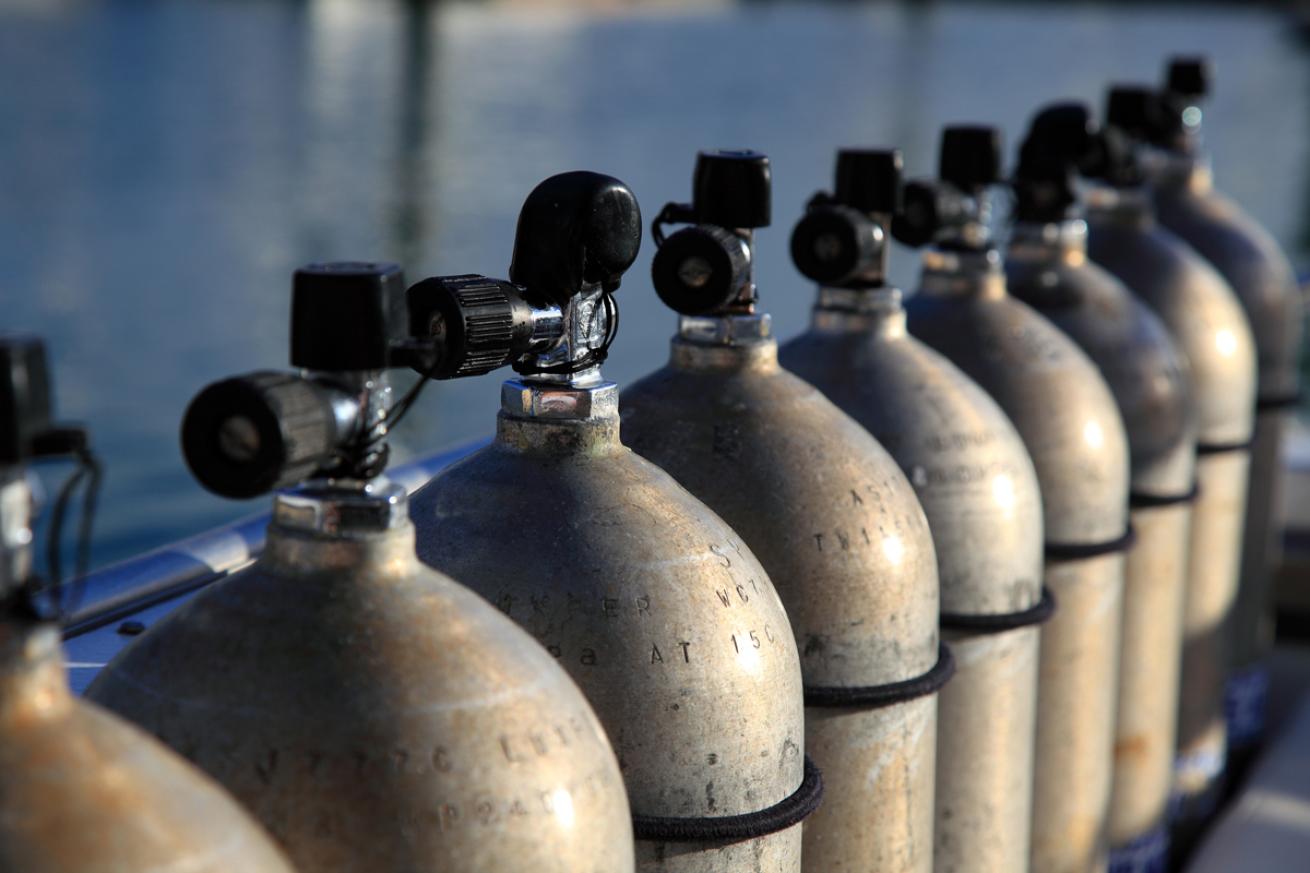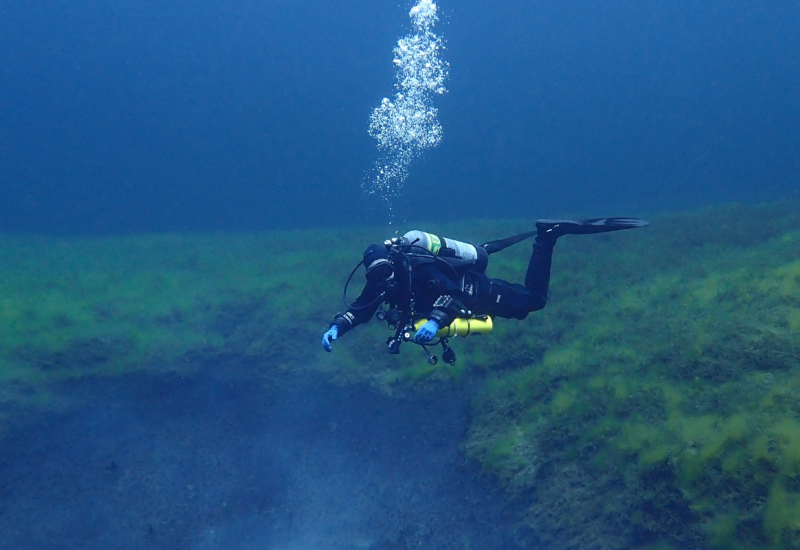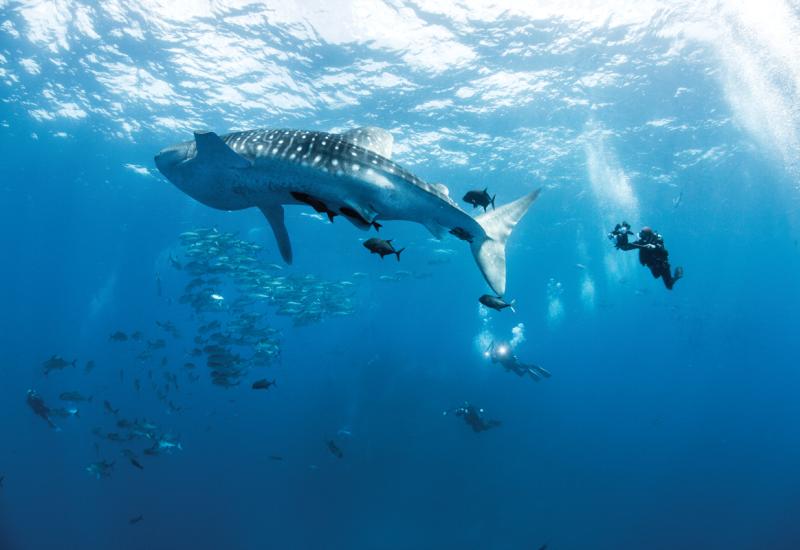Scuba Tank Markings: What Do They All Mean?

scuba tanks misc
Timothy Solano Wikimedia Commons
So why would anyone care about what’s stamped on a scuba tank? Maybe you’re in the market for a used tank and you want to get a sense of its age and history; maybe you want to make sure that guy at the dive shop isn’t trying to sell you a hydro before you actually need one; or maybe, being a gearhead, you’re just curious.
Standard tanks have standard crown markings. Other tanks, especially those of the steel variety, often will provide additional markings to indicate tare weight, maximum test pressure, carbon dioxide capacity, etc. The following markings were taken off an everyday aluminum 80 pulled from ScubaLab’s tank inventory; these types of markings can be found on virtually any tank.
Breaking the Code:
TC-3ALM-207 – Canadian regulatory authority markings.
TC = Transport Canada (showing the tank meets Canadian specifications).
3ALM = Canada’s specification code for 3-gauge aluminum.
207 = the tank’s service pressure (also referred to as working pressure), expressed in bars.
DOT-3AL-3000 – U.S. regulatory authority markings.
DOT = Department of Transportation (showing the tank meets U.S. specifications).
3AL = U.S. specification code for 3-gauge aluminum.
3000 = the tank’s service pressure (also referred to as working pressure), expressed in psi.
P697426
This particular tank’s unique serial number.
LUXFER 10A05 SO80
LUXFER = the tank’s manufacturer
10 = Month of manufacture
A = Inspection code symbol
05 = Year of manufacture
SO80 = Luxfer’s model/part number for this cylinder, indicating its capacity in cubic feet at normal working pressure (this is a standard 80 cubic foot tank; a SO40 would indicate a 40 cubic foot tank, SO30 a 30 cubic foot tank, and so on).
11 DO/69 12
Date of most recent hydrostatic test.
Got more information on scuba diving tank markings? Leave your tips in the comments below!

Shutterstock.com/Kaesler MediaScuba tanks loaded on the boat and ready for a dive trip.
How to Read Scuba Tank Markings
So why would anyone care about what’s stamped on a scuba tank? Maybe you’re in the market for a used tank and you want to get a sense of its age and history; maybe you want to make sure that guy at the dive shop isn’t trying to sell you a hydro before you actually need one; or maybe, being a gearhead, you’re just curious.
Standard tanks have standard crown markings. Other tanks, especially those of the steel variety, often will provide additional markings to indicate tare weight, maximum test pressure, carbon dioxide capacity, etc. The following markings were taken off an everyday aluminum 80 pulled from ScubaLab’s tank inventory; these types of markings can be found on virtually any tank.
Scuba Tank Markings Explained
TC-3ALM-207 – Canadian regulatory authority markings.
TC = Transport Canada (showing the tank meets Canadian specifications).
3ALM = Canada’s specification code for 3-gauge aluminum.
207 = the tank’s service pressure (also referred to as working pressure), expressed in bars.
DOT-3AL-3000 – U.S. regulatory authority markings.
DOT = Department of Transportation (showing the tank meets U.S. specifications).
3AL = U.S. specification code for 3-gauge aluminum.
3000 = the tank’s service pressure (also referred to as working pressure), expressed in psi.
P697426
This particular tank’s unique serial number.
LUXFER 10A05 SO80
LUXFER = the tank’s manufacturer
10 = Month of manufacture
A = Inspection code symbol
05 = Year of manufacture
SO80 = Luxfer’s model/part number for this cylinder, indicating its capacity in cubic feet at normal working pressure (this is a standard 80 cubic foot tank; a SO40 would indicate a 40 cubic foot tank, SO30 a 30 cubic foot tank, and so on).
11 DO/69 12
Date of most recent hydrostatic test.
More about Scuba Tanks and Regulations
In addition to the manufacturer codes and markings on scuba tanks, there are other regulations that are important to know and understand. Here are some of the most frequently asked questions regarding scuba tanks.
What is the Standard Size Scuba Tank?
Scuba tanks are measured in cubic feet and the most common size is 80 cubic feet. Scuba tanks do come in multiple sizes and some divers prefer to use a 100 cu. ft. tank since it holds more gas. Less common are pony bottles, that range in size from 40 to 63 cu. ft., but there is truly a tank size for everyone.
Do Scuba Tanks Expire?
The answer to this question varies by professional, but as long as you keep up with your tank's regular maintenance, including a visual inspection (VIP) completed once a year and a hydrostatic test every five years, you can make your scuba tank last.
What Two Metals are Scuba Tanks Made From?
Scuba tanks are made from both aluminum and steel. How you decide which to dive with is a matter of personal preference. Steel tanks weigh more which can be seen as a benefit to some divers who want to use less weight in their BCD or on their weight belt.










